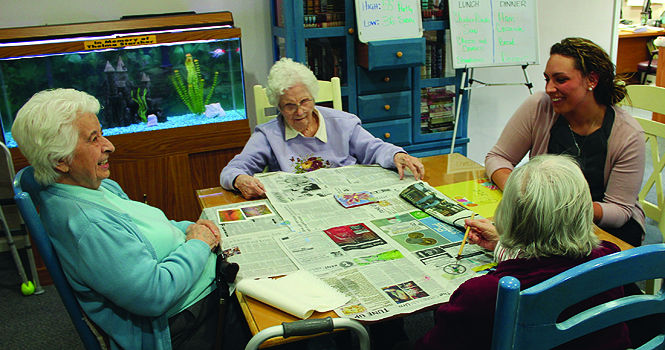Students use art to bond with elderly
NAEA vice president Krystin Smith converses with residents of Haven Homes. Photo by Rachel Campbell.
April 13, 2012
Kent State art students encouraged residents of Haven Homes, an assisted living facility in Stow, to use memories as inspiration for art during a visit to the home Thursday.
These students, who range from beginners to seniors, belong to the student chapter of the National Art Education Association, or NAEA. Assistant professor Linda Hoeptner-Poling accompanied them and was the driving force behind arranging these trips, which began about four weeks ago.
Dan Humphrey, president of the NAEA student chapter and junior art education major, said the group began to visit the home after Hoeptner-Poling found the home while looking for a place for her mother to live.
“We just noticed that the arts program that they do wasn’t anything spectacular,” he said. “It was kind of an experiment to see how it went and the residents, some who they say haven’t smiled in years, were happy and wanted us to come back.”
In addition to livening up the Haven Homes art program, Hoeptner-Poling hoped to introduce the students to a new teaching experience.
“I thought it would be good for our students’ experience because they’re very familiar with teaching children, obviously, but this is one population they don’t have experience in,” she said. “This is our second time here and it seems to be very enriching for the residents. They’re all participating, which is what we hoped for.”
The students have taught people with special needs and younger children in the past and have found similarities between that and teaching the elderly.
Krystin Smith, senior education major and vice president of NAEA, said the mentality of the elderly and the young are the same, except that the elderly need to be re-taught things they already knew.
“Sometimes it gets a little sad because you know that at one time they did know this and they’re so hard on themselves,” she said. “But otherwise it still is as rewarding for me as teaching a five-year-old or a student with special needs in high school.”
Humphrey also saw the reward in teaching the residents of Haven Homes.
“I really just enjoy the company that they give me and the company we give them,” he said. “A lot of them don’t really get to see their families that often, so when we come in they’re excited about it.”
Hoeptner-Poling believes creating art in general can be beneficial for all those involved, not just those who are teaching.
“In art education we believe that all ages, all abilities, anybody in the whole world can benefit from art-making,” she said. “You’re never too old to get meaning in your life through art-making, so this is something that enriches their lives. It stimulates their thinking.”
The NAEA student chapter worked to stimulate the residents’ thinking through projects that evoke past memories. The students encouraged residents to paint premade tiles to be arranged on a flowerpot and placed on one of Haven Homes’ patios.
“A lot of the residents suffer from dementia, so the first lesson we ever taught was sort of just like recreating a memory like looking at one of their photographs and thinking back on that and we just figured keep going with that theme,” Humphrey said. “We let them just think of something they love to do outside when they were younger or as a child and have them try to paint it.”
Overall, Hoeptner-Poling said both the students and the residents benefit from these experiences.
“The intergenerational interaction that they get is meaningful both for the art education students as well as the residents,” Hoeptner-Poling said. “It’s really a mutual positive relationship that they’re experiencing.”
Contact Rachel Campbell at [email protected].

























